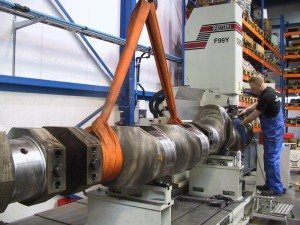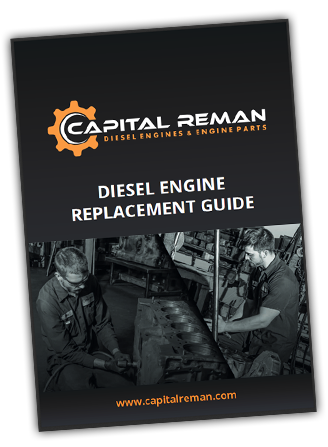Remanufactured Crankshafts
 All Capital Reman Exchange crankshafts are precision machined to exact tolerances with no odd size crankshaft bearings or journals. Thrust surfaces are micro-polished to provide precise surface finishes for smooth engine operation and reduced thrust bearing wear. Every journal is inspected and measured with critical accuracy. After machining, oil holes are chamfered to improve lubrication and every journal polished to a smooth finish for long bearing life. Remanufactured crankshafts are thoroughly cleaned with special emphasis to flushing and brushing out oil passages to remove any contaminants. Our crankshafts are guaranteed for 1 year under our warranty.
All Capital Reman Exchange crankshafts are precision machined to exact tolerances with no odd size crankshaft bearings or journals. Thrust surfaces are micro-polished to provide precise surface finishes for smooth engine operation and reduced thrust bearing wear. Every journal is inspected and measured with critical accuracy. After machining, oil holes are chamfered to improve lubrication and every journal polished to a smooth finish for long bearing life. Remanufactured crankshafts are thoroughly cleaned with special emphasis to flushing and brushing out oil passages to remove any contaminants. Our crankshafts are guaranteed for 1 year under our warranty.
Our crankshaft department is meticulous when it comes to every detail of the remanufacturing process. We prefer to adhere to a quality standard over a volume standard in an effort to ensure our work is accurate and top quality. We work diligently with quality in mind to reduce your downtime and deliver your remanufactured crankshafts as efficiently as possible.
25 Point Crankshaft Remanufacturing Process
Step 1: Industrial Crankshaft Cleaning
The first step in the industrial crankshaft remanufacturing process is cleaning the entire crankshaft. We soak our rebuilt crankshafts in a hot tank and use Hotsy® on the overall shaft as needed. We then wire brush all oil holes to remove caked on residue and other substances.
Step 2: Inspection and Magnaflux
The second step in the industrial crankshaft remanufacturing process is using a magnaflux method to check for cracks. The industrial crankshaft is maganitized and sprayed with a magnaflux powder which, under blacklight conditions, makes any cracks or imperfections visible. All reman crankshafts are magnafluxed for imperfections, no exceptions!
Step 3: Check Counterweights
We remove and clean the counterweights. We check the counterweights to make sure they are tight. If the counterweights are loose we then replace all of the counterweight bolts. Counterweights are inspected for cracks before being replaced or retightened. In step sixteen we re-install the counterweights back into the rebuilt crankshafts.
Step 4: Check Crankshaft Bearings and Straightness
We inspect the entire incoming remanufactured crankshafts for damage. We then determine the size of the journals and mains. We also check the hardness of the mains and journals. We also inspect the crankshaft bearings and check the straightness of the overall crankshaft. Re-straightening the industrial crankshaft if not up to OEM standards occurs in step seven. We typically do not re-straighten our rebuilt crankshafts until we check the bolt holes and seal the surface for divots.
Step 5: Check Bolt Holes
We check the keyway, nose, bolt holes and seal the surface for non-conformities. We tap bolt holes up to but not more than ½” on all remanufactured crankshafts.
Step 6: Stamp Counterweight Webbing
We stamp the counterweights & webbing in proper firing order (alpha if numeric & vice versa). We also stamp the employee ID#, Work Order # and date on #1 rod webbing. Stamping this information on the rod webbing helps keep our quality control process the best in business.
Step 7: Re-straightening for Rebuilt Crankshafts
The seventh step is industrial crankshaft re-straightening. If the reman crankshaft is deemed un-straight than we use the Gleason Straightening Machine® on the crankshaft. The straightening machine determines how many dials are out of line. To re-straighten the shaft our technicians heat up the crankshaft to 500-600 degrees. Any more than 700 degrees takes the hardness out of the shaft. The Gleason® Straightener process corrects the bent crankshaft to the proper OEM specifications for rebuilt crankshafts.
Step 8: Repeat Magnaflux Process
The eight step in the process is repeating the magnaflux process if straightening was performed. Anytime metal is being stressed it is imperative to re-inspect for cracks and structural imperfections on the reman crankshaft.
Step 9: Undercutting for Remanufactured Crankshafts
The ninth step in the industrial crankshaft remanufacturing process is undercutting. Our technicians undercut the rod or journals to eliminate wear before buildup. This is one of the many little things we do to produce the best remanufactured crankshafts possible.
Step 10: Thermal Spray All Rebuilt Crankshafts
The tenth step is the prevention of further buildup via metalizing often called thermal spraying. Thermal spraying has been around for well over 100 years but is still widely known as the best preventative corrosion fighting technique in the world. Thermal spraying is also known for changing the surface of the metallic component and is common with rebuilt crankshafts. Thermal spraying involves protrusion of molten particles onto the heated metallic surface where is bonds and forms a smooth coating interwoven into the structure. There are many different types of thermal spray alloys that can be employed for remanufactured crankshafts. Typically, Boron Alloys are used as they very dense, hard and are oxide free. They also prevent against abrasive materials that cause divots, scratches and cracks in addition to preventing surface erosion and corrosion. Thermal spray is an important step we believe in, but not always performed in the industry.
Step 11: Industrial Crankshaft Welding
The welding process for remanufactured crankshafts is called submerged dark welding. It is a powdered flux plus a weld which combines to produce a more precise weld. The flux powder is from Gleason and is called #1 Flux 2245 HD. This powder eliminates the need for our technicians to wear weld masking and reduces the amount of dust by-product. 
Step 12: Relieve Structural Stress
The twelfth step is to relieve stress upon the entire rebuilt crankshaft structure by heating it up again to 500-600 degrees.
Step 13: Recheck for Straightness
Next step is to check for overall straightness of the reman crankshaft once again. If the reman crankshaft is out of alignment then we repeat step 7 and restraighten the structure. Each of our remanufactured crankshafts is checked multiple times throughout the remanufacturing process to ensure quality control. If the straightness is not compromised our rebuilt crankshafts can proceed to step thirteen which is crankshaft grinding.
Step 14: Rough Crankshaft Grinding
One of the most important steps in the remanufacturing process of industrial crankshafts. This step involves rough grinding the excess material from the rod or journals and is known as crankshaft grinding. On the rod there are various mains that need to be reground to proper OEM specifications. These rods are spun grind to the next undersize using the Berco Polterson Crankshaft Grinding Machine. Rod mains are ground inside and outside. We have the ability to “crankshaft grind” any size to bring back to standard OEM specifications.
Step 15: Finished Crankshaft Grinding
Next we perform a finished crankshaft grinding procedure. The finished crankshaft grinding is a more precise grind which reaches the correct OEM specifications. Before we start the crankshaft grinding we see what crankshaft bearings are available and start from there. For example the OEM specification for a 3306 CAT Rod is 2.9987” – 3.0003”. Our industrial crankshaft grinding technicians always stop at the high end of our tolerance level. We further refine the crankshaft grinding process in our micro-polishing process at step eighteen.
Step 16: Shot Peening the Remanufacturing Crankshaft
The next step is to process the industrial crankshaft in our shot peen machinery. Shot peening adds an additional layer of hardness to the reman crankshaft.
Step 17: Replace or Retighten Counterweights
Replace the counterweights in proper firing order. Either the new counterweights are installed or the old counterweight bolts are retightened and tested.
Step 18: Determine Proper Balance
We determine the proper balance of our remanufactured crankshafts is achieved. In the engine the crankshaft, pistons and rods all in a constant rotation. The counterweights are designed to offset the weight of the rod and the pistons in the engine. When in motion the kinetic energy and the sum of all forces should be equal to zero on all moving parts. If the reman crankshaft counterweights are imbalanced it adds additional stress on other components of the engine. We make sure the internal balance and the external balance of the crankshaft counterweights are properly aligned.
Step 19: Micro-polishing the Rebuilt Crankshaft
Then we micro-polish each of our rebuilt crankshafts by hand. To further refine the crankshaft grinding process we make the most precise fit by micro-polishing the component with a 600 grit emery cloth. Through micro-polishing and industrial crankshaft grinding, we achieve the recommended Rockwell hardness and Ra finish (Roughness Parameter).
Step 20: Test Reman Crankshaft Rockwell Hardness
We then check the industry standard hardness. Standard hardness is 40 on the Rockwell hardness scale. A 45-50 rating is what we try to employ for all of our remanufactured crankshafts as we like to go beyond industry standards. Typically, hardness can be reduced if the engine is out of oil or the journal is spun incorrectly.
Step 21: Final Quality Control Inspection
Quality control inspects all of the finished reman crankshafts for internal and external mistakes. Our quality control department uses separate testing and analytical measurement tools from our technicians to ensure accuracy. If our rebuilt crankshafts pass our quality control inspection it goes onto the rust proofing stage.
Step 22: Rustproof Remanufactured Crankshaft
We apply rust proofing to all of our remanufactured crankshafts using Cosmoline, which is standard rust-proofing for engine parts.
Step 23: Packaging
We pack the rebuilt crankshafts correctly. We cover the rod journals (varies per crankshaft) with paper & tape in place.
Step 24: Verify Work Order and Warranty
We verify the work order contents and the warranty on file and make sure all records are listed in the order. Our billing department and quality control department verify everything is in working order before we ship the industrial crankshaft to its final destination.
Step 25: Ship the Completed Remanufactured Crankshaft
Finally, we ship the remanufactured crankshaft to the customer.
1 Year Warranty Program
 REMANUFACTURED CAMSHAFTS, LIFTERS/FOLLOWERS, CONNECTING RODS, CRANKSHAFTS, CYLINDER HEADS, CYLINDER BLOCKS, ENGINES
REMANUFACTURED CAMSHAFTS, LIFTERS/FOLLOWERS, CONNECTING RODS, CRANKSHAFTS, CYLINDER HEADS, CYLINDER BLOCKS, ENGINES
Capital Reman Exchange, LLC warrants its remanufactured products to be free from defects in material or workmanship and provides a warranty that includes 12 months unlimited miles. Read the entire warranty program here.
Contact a Capital Reman sales representative today for more information about Crankshafts!
Call Capital Reman Exchange Today at 1-844-239-8101 For Immediate Sales Service or Read Our FAQ Page to Learn More.









